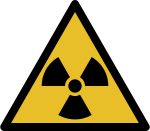Портал ядерных технологий

The Dayton Project began in 1943 when Monsanto's Charles Allen Thomas was recruited by the Manhattan Project to coordinate the plutonium purification and production work being carried out at various sites. Scientists at the Los Alamos Laboratory calculated that a plutonium bomb would require a neutron initiator. The best-known neutron sources used radioactive polonium and beryllium, so Thomas undertook to produce polonium at Monsanto's laboratories in Dayton. While most Manhattan Project activity took place at remote locations, the Dayton Project was located in a populated, urban area. It ran from 1943 to 1949, when the Mound Laboratories were completed in nearby Miamisburg, Ohio, and the work moved there.
The Dayton Project developed techniques for extracting polonium from the lead dioxide ore in which it occurs naturally, and from bismuth targets that had been bombarded by neutrons in a nuclear reactor. Ultimately, polonium-based neutron initiators were used in both the gun-type Little Boy and the implosion-type Fat Man used in the atomic bombings of Hiroshima and Nagasaki respectively. The fact that polonium was used as an initiator was classified until the 1960s, but George Koval, a technician with the Manhattan Project's Special Engineer Detachment, penetrated the Dayton Project as a spy for the Soviet Union. (Full article...)
Feynman developed a widely used pictorial representation scheme for the mathematical expressions describing the behavior of subatomic particles, which later became known as Feynman diagrams. During his lifetime, Feynman became one of the best-known scientists in the world. In a 1999 poll of 130 leading physicists worldwide by the British journal Physics World, he was ranked the seventh-greatest physicist of all time.
He assisted in the development of the atomic bomb during World War II and became known to the wider public in the 1980s as a member of the Rogers Commission, the panel that investigated the Space Shuttle Challenger disaster. Along with his work in theoretical physics, Feynman has been credited with having pioneered the field of quantum computing and introducing the concept of nanotechnology. He held the Richard C. Tolman professorship in theoretical physics at the California Institute of Technology.
Feynman was a keen popularizer of physics through both books and lectures, including a 1959 talk on top-down nanotechnology called There's Plenty of Room at the Bottom and the three-volume publication of his undergraduate lectures, The Feynman Lectures on Physics. Feynman also became known through his autobiographical books Surely You're Joking, Mr. Feynman! and What Do You Care What Other People Think?, and books written about him such as Tuva or Bust! by Ralph Leighton and the biography Genius: The Life and Science of Richard Feynman by James Gleick. (Full article...)
Более подробную информацию по этой теме можно найти в следующих родственных проектах Фонда Викимедиа :